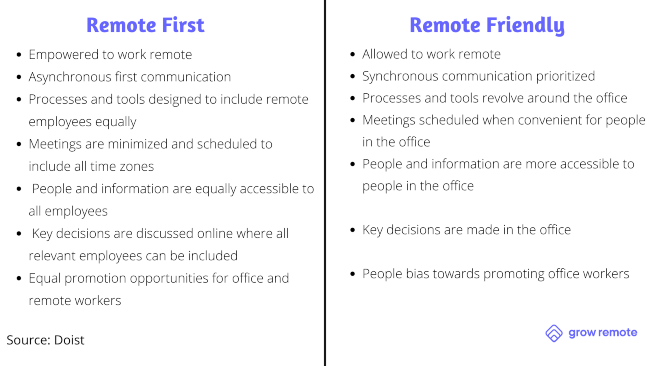Remote work can be a game-changer for gender equality – but companies need to adapt to ensure everyone benefits equally, writes Joanne Mangan from Grow Remote.
When it comes to the conversation around remote work and women’s progression in the workplace there are usually two opposing sides, with remote work as the great equaliser on one side and as a potential driver of greater inequality on the other.
The reality is that the potential for remote work to lead to greater gender equality is huge, but not without changes to the underlying norms and structures which permeate our society and our working lives.
“There is a real danger that without a cultural shift in how we think about remote work, women will be disadvantaged in the post-pandemic workplace”
If we proceed with business as usual, with remote work thrown into the mix, we will never fulfil the potential that remote work can offer to women and, as a result, to companies and the wider economy.
First, let’s talk about the benefits for women
One of the biggest is flexibility – remote work gives working mothers with young children the flexibility to progress in the workplace while still balancing their caring responsibilities. Having the opportunity to stay and flourish in their careers during the years in which they are also raising their children has the potential to be truly transformative in terms of increasing women’s representation in leadership roles and closing the gender pay gap.
It can be argued that the shift to remote work during the pandemic has removed some of the stigma associated with balancing caring and working duties and has led to a greater appreciation of the importance and value of care work.
Suddenly care work, which has traditionally been invisible in the workplace, has become visible, with children barging in on Zoom meetings or employees having to ask for time off to manage home-schooling. And one of the positive side-effects of remote working has been the opportunity it has provided for fathers to take on more of the caring responsibilities in the home.
At Grow Remote we have spoken to women who say that they no longer have to worry about being stuck in a meeting which has run over time, watching the clock tick by, then racing to the creche before it closes.
And it is not just working mothers who have felt the benefits of working remotely, women who do not have children also enjoy the benefits which remote work can bring. Research has found that remote work removes the bias of physical stature and puts communication back on an equal footing.
No longer having a long commute to and from the office gives everyone more time to spend with family, dedicate to personal wellbeing or use to benefit the local community.
Laura, a sales support analyst and fully remote worker told us: “Personally, I have never felt comfortable in a traditional office environment and so to be able to work from home is a breath of fresh air” while Catriona, another fully remote employee and customer support lead said “the greatest impact that remote working had on my career was the opportunity to work with a tech company without having to move to Dublin.”
It is not enough for employers to simply allow their employees to work remotely
Recent research by McKinsey and Lean In found that one in four women are thinking about reducing or leaving paid work as a result of the pandemic. Women working remotely have taken on a greater share of unpaid care work such as housework, childcare and taking care of the elderly and a recent survey of female-led businesses across Europe found that 50% of respondents said the pandemic has had a strong to severe impact on their work/life balance.
Need for a cultural shift
There is a real danger that without a cultural shift in how we think about remote work, women will be disadvantaged in the post-pandemic workplace.
Women we have spoken to highlight the difficulties they have encountered in getting their voices heard in a virtual environment in male-dominated organisations. As Laura explains, “I would worry with regards to visibility to management for progression and recognition, but I believe merit should be placed on the work itself”.
As we move forward, it is possible we will see a gender skew, with women disproportionately working remotely while men return to the office, leading to the possibility of a two-tier workforce, with women being less visible and perceived as being less invested in their careers as a result. If we row back on the hard-fought advances made by women in the workplace over the past decades, the impact will be felt not only by women, but by businesses and the wider economy.
History has shown us that changes which can appear to be equal often do not have equal outcomes.
We are at the precipice of a remote working revolution and it is critical that we put the right conditions in place to ensure the impacts of this are felt equally by men and women. The question we should be asking is not ‘is remote work good for women’ but rather ‘how can we ensure women and men benefit equally from remote work?
How can employers ensure the benefits of remote work are enjoyed equally?

- 1. Be ‘remote-first’ not ‘remote-friendly’: This is one of the most important steps you can take as an employer when planning your future workplace. Remote-first organisations recognise that remote workers are on an equal footing with office-based staff and build their policies and processes around this principle. In a remote-first culture, women will not be disadvantaged if they choose to work remotely, as the workplace will be designed with everyone on an equal footing. Remote-first means decisions are made online and transparently, not during post-meeting chats or over Friday evening drinks; and success is measured by output rather than by who is staying late in the office.
- 2. Empower managers to lead in a remote-first environment: Build awareness of potential conscious or unconscious biases which may harm the career aspirations of women who do not follow the traditional 9 to 5 working day. Managers should also be supportive of men who want flexible working conditions and a better work/life balance and who may be worried about the effect this will have on their career aspirations. Educate managers to be mindful of conflicts between work and home which may be causing stress. Create virtual communication guidelines which ensure that all voices are heard and not just those who are able to shout the loudest, and make sure managers are reinforcing these guidelines on a regular basis. And this point cannot be stressed enough – encourage managers to work remotely.
- 3. Capture data from within your organisation: To better inform your remote-first framework, gather data on what is happening within your own organisation to better understand how remote work will be distributed across gender and other intersecting factors such as age, race or disability. For example, are more men than women planning to opt for remote work? Will your remote workforce be made up primarily of older employees or younger?
- 4. Include a diverse range of voices: Look at who is involved in your decision-making processes and ensure a diverse range of voices are heard, not only women but those representing a range of viewpoints such as age, disability, race, ethnicity and parental status.
What women say
Finally, take a look at the advice for employers below, directly from the women we at Grow Remote have spoken to:
- Catriona, Customer Support Lead: “As an employer, do you have to have everyone in the office, 40 hours a week? Does it have to be a rigid 9 to 5? Or are there opportunities to say to someone – take the time you need to drop and collect your kids from school, and make the time back later. This notion of trying to pretend that your family or personal life doesn’t exist has to stop – because otherwise people will burn out faster and leave jobs for places that have more flexibility.”
- Sharon, Vice-President of Technology: “There are many biases in business today and this new future of work has the opportunity to add even more if we are not very intentional in how we support, engage, retain and develop our females in the workplace. Companies will need means to track the data to ensure they maintain a strong culture inclusive of all. Understanding the gender distribution at home and in office will be key to ensure that equal amount of flexibility and hybrid access for everyone.”
- Jennifer, Director Global Pricing Transformation & Business Analytics: “Be mindful of the fact that opening hours of childcare and school hours may need to slot into the working schedule; for those of us working as part of global organisations that time-zones be respected when it comes to scheduling meetings”
- Maggie, Senior Product Manager: “This is a very new landscape for employers and employees. Work with the teams to build processes and policies that are inclusive of everyone in the organisation. Be open, honest and flexible.”
Joanne Mangan is Employers Lead at Grow Remote
Published: 8 March, 2021






